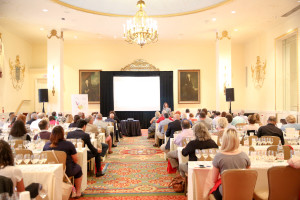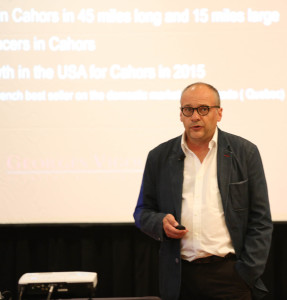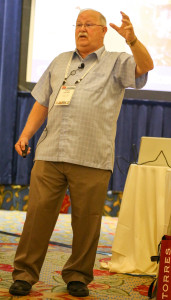The following sessions were enjoyed by all on Friday afternoon, August 12, 2016 as part of SWE’s 40th Annual Conference, held at the Mayflower Hotel in Washington DC!
Dry White Bordeaux: Presented by Mary Gorman-McAdams, MW and Linda Lawry, DWS, CWE: This class started with a discussion of dry white wines in the overall context of Bordeaux, and it was quite enlightening! For instance, dry white wines represent only about 9% of the output of Bordeaux—and this includes Crémant!
To put the numbers into context, Bordeaux has 10 appellations and 24,000 acres (9.800 ha) of vines dedicated to white wine. Of the vineyard area, about 47% is dedicated to Sémillon, 45% to Sauvignon Blanc, 6% to Muscadelle, and the remaining 2% to a smattering of other allowed grape varieties that include Colombard Blanc, Ugni Blanc, Merlot Blanc and Folle Blanche.
This introduction was followed by a deep discussion of the grape varieties, soils, and winemaking techniques used in conjunction with the wine whites of Bordeaux. Following this, was a tasting that highlighted some of the leading white wine appellations of Bordeaux. Included in the tasting were the following wines: Château Sainte Marie Vieilles Vignes 2015 Entre-Deux-Mers, Château La Freynelle Bordeaux Blanc 2015, Château du Champs du Treilles “Vin Passion” Sainte-Foy-Bordeaux 2013, and Château de Cérons Graves Blanc 2013. These wines represented the following white wine appellations of Bordeaux: Entre-Deux-Mers AOC (exclusive to white wines), Bordeaux Blanc AOC (the largest white wine appellation), Sainte-Fox-Bordeaux AOC (an appellation for red, white, and sweet whites), and Graves AOC (an appellation for both whites and reds). To discover the rest of the wines tasted, and the rest of the story of dry white Bordeaux, click here to download the handout and slide show for Dry White Bordeaux-presented by Mary Gorman-McAdams, MW, DWS.
Betting on Malbec–the Different Terroirs of Cahors: Presented by Bertrand-Gabriel Vigouroux: This fascinating session started out with the story of the history of “the Black Wine of Cahors.” Here’s just a small bit of the story: Jean XXII, the second Pope in Avignon, was born in Cahors and brought a winemaker from Cahors with him to plant the vineyards of Châteauneuf-du-Pape and to help build the Palace of Avignon. For many generations in the pre-phylloxera era, Malbec was one of the main grapes planted in Bordeaux. While the Malbec grapes in Bordeaux and Cahors were decimated by phylloxera, by this time Michel A. Pouget had brought the Malbec grape to Argentina where it continues to thrive.
Today, while there are over 40,000 hectares of Malbec in Argentina, there are approximately 4,400 hectares in Cahors. The region of Cahors is about 45 miles long by 15 miles wide, with over 300 different producers. Georges Vigouroux is considered to be one of the pioneers of the modern era of Cahors, having purchased and restored the Château de Mercues, the oldest château in Cahors, in 1983. The château now houses a winery and hotel, and is credited with the beginnings of “oenotourism” in the area.
The session continued with a discussion of the soils and terroir of Cahors, and ended with a tasting that included Château Leret-Monpezat Grand Vin Cahors 2012, Crocus ‘L’Atelier’ Malbec de Cahors 2012, and Chateau de Haute-Serre Malbec de Cahors 2014 (among others). To read more about the wines and the session, click here to download the slideshow – Betting on Malbec-the Terroirs of Cahors-presented by Bertrand-Gabriel Vigouroux.
Exploring the Haut-Savoie in Wines and Spirits: presented by Hoke Harden, CSW, CSE—Hoke Harden CSW, CSE took his class on a voyage through history from the Carolingian Empire, to the Kingdom of Arles, and finally to the House of Savoy. Following the expansion of a single county, which became a Duchy, which included a Principality, which became a Kingdom, then another larger Kingdom, the House of Savoy also contained diverse and remarkable wine- and spirit-producing regions, which included, at times, Savoy, Bugey, Isere, Aosta, and Piedmont, among others.
Wines tasted included Berthollier Chignin Vielles Vignes 2013 (Jacquere) Vin de Savoie, Maison Anselmet Torrette Superieur Vallée d’Aoste DOC, and Tenuta de Fontanafredda Serralunga di Alba Barolo. Spirits and aromatized wines were also included in the tasting, such as Cocchi Vermouth di Torino, Vermouth de Chambéry, and Dolin Génépy des Alpes.
To read more about these wines, spirits, and the historic House of Savoy, click here to download the handout and slideshow Wines and Spirits of the House of Savoy-presented by Hoke Harden CSW, CSE.
We will be posting additional conference recaps in the next few days. In addition, we are building our permanent archive of notes from the 2016 SWE Conference-click here! If you are a conference speaker who would like to share your materials, please contact Jane A. Nickles at jnickles@societyofwineeducators.org


